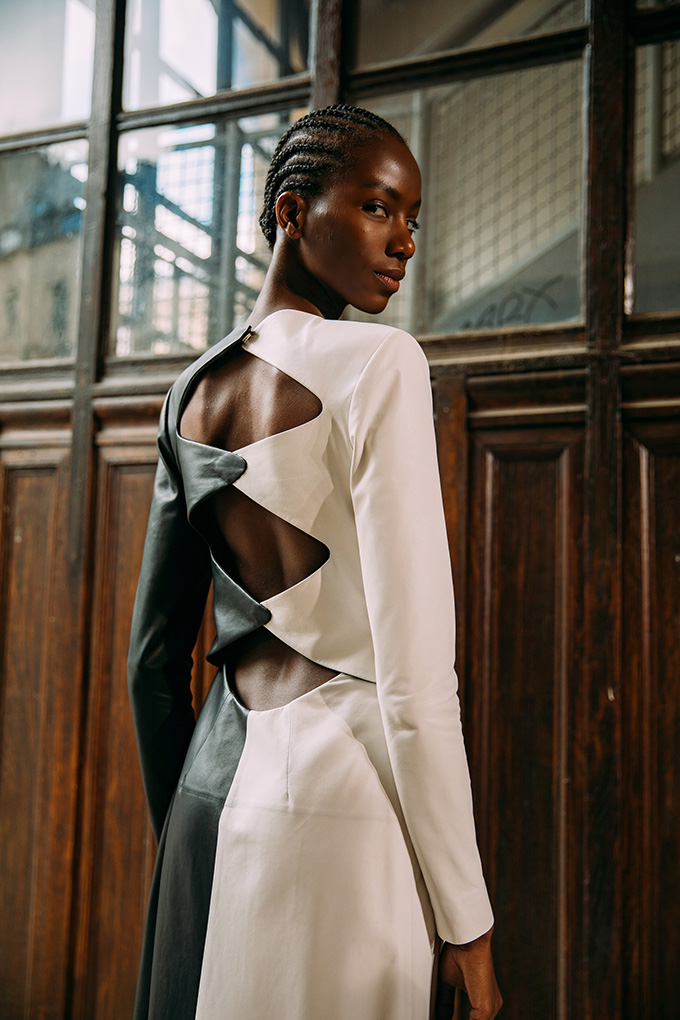Gabriela Hearst is used to working under the constraints of a crisis. “We’ve been operating with an environmental crisis in our head,” she tells Vogue via Zoom from her studio in New York. While the pandemic has undoubtedly brought about new challenges for designers, Hearst’s sustainable approach arguably makes her one of the best-equipped to deal with them—as evidenced by her spring/summer 2021 menswear collection, which was created using 100 percent deadstock materials. “We didn’t buy one fabric,” she says. “I’m excited so many other designers are using deadstock; the pandemic has forced people to.”
For spring/summer 2021, Hearst—who now counts the Duchess of Cambridge among her high-profile fans—has been no less ambitious, choosing to make her debut at Paris Fashion Week this season. “During the pandemic, we make plans, and if things change, you adapt,” she explains, matter-of-factly. “But at least you’ve got a northstar of where to go.”
Ahead of her show in Paris, Hearst speaks to us about her latest collection, why she’s always striving to be more sustainable, and why her children make her hopeful for the future.
How would you describe your approach for spring/summer 2021?
Complete insanity. It’s like, “How can we make things even more complicated besides being in a pandemic?” The collection is extremely handcrafted: there are shells beaded to dresses; remnants of lace embroidered together; inserted leather pieces with knots—techniques that we’ve never done before. It still has our core goal [in mind], which is creating the highest-quality product with the lowest impact on the environment.

You’ve set an ambitious goal of using no virgin materials by 2022. What progress are you making on the sustainability front?
It’s important for us to move to a circular [model] sooner rather than later—hopefully we can achieve that in the next 18 months. We’ve used more than 60 percent deadstock in our spring/summer 2021 collection and we also launched the Garment Journey [which gives customers information about materials used and the production process via QR codes on the garments’ labels] to bring traceability to our products. But I’ll never be satisfied with our environmental practices because there are always ways of doing it better. I want us to ship more by boat, which is where we are lacking.
What’s behind your decision to show at Paris Fashion Week this season?
When we were shooting our resort collection, we lost one of our boxes [in transit], which was a third of the collection. I was like, “I can’t do this again.” The majority of our pieces are made in Italy so we felt environmentally and logistically it was much better to do it in Paris.
Also, it’s Paris! The show itself is going to be much smaller [than previous seasons], in a beautiful garden at the [École des] Beaux-Arts. We’re going through all the [COVID-19] regulations and making sure we keep people safe. The digital part of the show, which is a world that’s very difficult for me to comprehend because I’m such a physical person, is going to a wider audience. It’s about being very personal—my friend is going to play the music—and we’re doing it with people who we love.

You won the CFDA American Womenswear Designer of the Year award in September. How did it feel to get that accolade?
We’re really honoured. It’s so humbling and I [have a lot of] gratitude; it couldn’t have come at a better time, to have something like this to celebrate and to lift us up in the current situation. But for us, we feel like, “We’ll celebrate today, then we move on.” On the day we got the CFDA award, we were also super excited because we secured this biodegradable tape for shipping. My friend was telling me, “That’s so typical you’re excited about that in the same way you’re excited about the CFDA.” But they are missions we have to accomplish; we have so many pieces in the puzzle [to solve].
Do you think the pandemic will lead to the fashion industry taking a more sustainable approach in general?
The optimistic part of me says yes. At least people are talking about sustainability. It wasn’t that long ago that I was talking about sustainability and a consultant said to me, “Don’t say that, you’re going to open up a can of worms.” Sometimes the fear of not doing it right is stopping people from doing it at all—we don’t have that luxury anymore. Now people understand that overproduction pushes overconsumption; we’re all uncomfortable with that. But there has to be accountability. There’s not a governing body that regulates me; it’s my moral compass and us doing all the homework.

Have we reached a tipping point when it comes to the climate crisis?
The experts are saying we have five years [before we could reach 1.5C of warming]. The pandemic has become another crisis, but a crisis that I believe with confidence that we will survive. It won’t make our species extinct, but the environmental crisis could. So for us, it’s always about how are we going to do business 10 years from now, when there are water shortages? How is all this going to matter when you don’t have new natural resources available?
With everything that’s going on, a lot of people are feeling despair right now. What makes you hopeful for the future?
My children. My 12-year-old daughters assume there’s going to be a shitshow, but one wants to be a journalist and the other wants to be a human-rights lawyer. Their idol was [the late US Supreme Court Justice] Ruth Bader Ginsburg; when I was growing up, my idols were princesses. When our neighbour recently cut down a 100-year-old tree, I just bawled and said to my son, who is five, “What is more important, a car or a tree?” He said, “A tree.” I truly believe children know what is more valuable. That’s what I really have to hope on.





